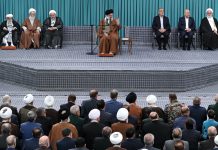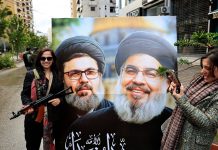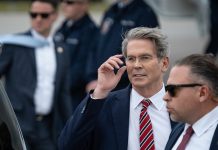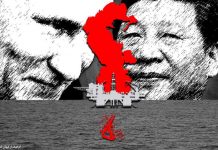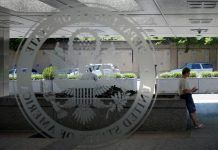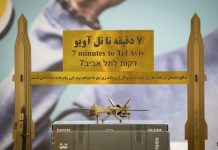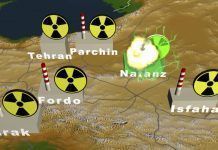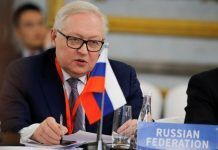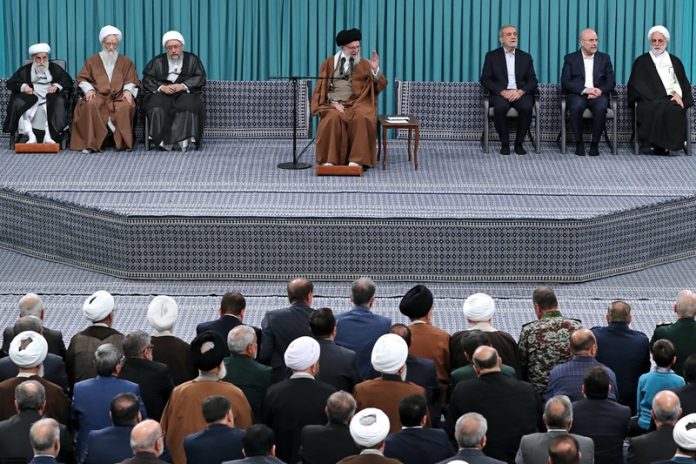
The Islamic Republic is currently facing multiple threats to its survival. Divisions between the government and the people have grown deeper, and tensions with the U.S. and Israel have escalated, pushing Iran to the brink of military conflict.
At a critical crossroads, it must choose between accepting the “poison chalice” or engaging in military conflict. Meanwhile, internal battles and disagreements among the government’s various factions have intensified.
Both widespread popular dissatisfaction and the looming threat of war pose significant dangers to the regime. The factional splits are another major threat.
One faction of the ruling elite supports negotiations with the Trump administration while another vehemently opposes them, viewing the talks as an unfair concession to the U.S. and a betrayal of the regime’s core values. Some even consider war a preferable alternative to a negotiated settlement
Less than a year ago, during his presidential campaign, Iranian President Massoud Pezeshkian introduced the ‘National Unity’ initiative. He consistently emphasized the need for programs fostering unity among various political factions, calling it a “necessity.”
Yet just seven months after the official formation of the 14th government of the Islamic Republic, internal government conflicts have escalated. Some analysts close to Pezeshkian now argue that the national unity project has failed. Others warn that the growing divisions and a failure to achieve unity could impose additional costs on the government.
Ahmad Zeidabadi, a reformist journalist and a supporter of Pezeshkian during the election, said: “Unity has reached an impasse, at least regarding the factions within the government aligned with the Front of Islamic Revolution Stability [far-right end of the fundamentalist spectrum] and similar political groups.”
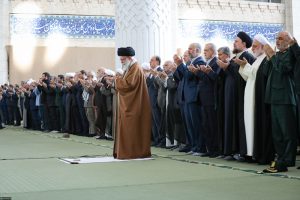
This reformist journalist added: “What happened in 2024 was that signs came from the system showing it was open to someone with Pezeshkian’s views.”
“Had I been certain from the beginning that they would not support this idea, there would have been no reason for Pezeshkian to step in! The entire state apparatus would have been riddled with discord and conflict, and the repercussions would have fallen on the people,” Zeidabadi explained.
Zeidabadi, who views Iran’s Supreme Leader Ali Khamenei as the embodiment of the “system,” argued: “Following the incident involving the previous president [Ebrahim Raisi, who died in a helicopter crash in May 2024], the system sent a different signal, both by confirming Pezeshkian’s candidacy and by not blocking his campaign.”
As a reformist who initially expressed reservations about voting for Pezeshkian, Zeidabadi later declared that he would indeed vote for him in the final days before the July 2024 election. He said he was one of the key architects and decision-makers behind Pezeshkian’s candidacy.
Yet he acknowledged: “The crises escalated significantly and reached a critical point, and if the system recognized this, it sought to moderate the situation through Pezeshkian, aiming to find a middle ground or bring in new forces. With that in mind, we decided to let him run!”
Zeidabadi, acknowledging the failure of the national unity project — one of the key political initiatives of his chosen president — also justified the decision to involve Pezeshkian in the election.
“If voting for Pezeshkian helped delay or even slightly moderate the overthrow, from my theoretical standpoint, it is not necessarily a bad thing,” Zeidabadi argued.
Reformists, who previously employed the “bad and worse” strategy during the presidential elections between Pezeshkian and Saeed Jalili (a staunch hardliner) –urging voters to choose Pezeshkian by instilling fear of Jalili’s potential rise to power — are now accusing Jalili of establishing a “shadow government” that has hindered Pezeshkian’s ability to govern.
This claim comes even though the July 2024 election was marred by a voter boycott, resulting in Pezeshkian winning the presidency with the lowest voter turnout in history.
The reformist newspaper Shargh published an article about Jalili, stating: “Over the past decade, the shadow government led by Saeed Jalili has functioned as an unofficial overseeing entity, aiming to critique and propose alternatives to the current administration’s policies.”
“While they have sought to advance their views, they have consistently avoided taking responsibility for their actions. Moreover, they continue to attempt direct involvement in government affairs, stoking political tensions,” the paper added.
The underlying cause of the disagreements between government factions is a battle for increased power, driven by the desire to capitalize on insider deals and expand networks of corruption and misconduct.
While many of these conflicts unfold behind closed doors, reports occasionally surface in the media, only to be later confirmed or denied, revealing the escalating tensions within the government and its various factions.
For example, recent social media and government-linked websites have reported rumors of 43 Majlis members (Iranian Parliament) from the Front of Islamic Revolution Stability collectively resigning.
However, Iman Shamsaei, the head of the Parliamentary Center for Communications, Media, and Cultural Affairs, later denied the news.
Shamsaei took to social media, stating: “There has been no resignation. I asked the two MPs to confirm, and they firmly rejected it as a rumor.”
Reformists, including Zeidabadi, are actively discussing the need for unity while highlighting two main concerns: tensions with the West and the more pressing issue of the regime’s diminishing legitimacy, which could lead to widespread public protests against the leadership.
In this context, Azar Mansouri, the secretary-general of the reformist Islamic Iran Nation’s Union Party, warned in an interview with Tehran-based Didarnews that “if the government fails to address the ongoing challenges and crises, Iran will face a troubling situation.”
Mansouri highlighted the growing divide between the Iranian people and the Islamic Republic, noting an increase in public dissatisfaction, warning, “God forbid if the people’s anger overtakes their fear.”
She also predicted that even if an agreement with the West is reached, the current situation will only deepen the rift between the government and society, leaving Iran’s future uncertain.
Meanwhile, Pezeshkian’s government is focused on reducing the gap between the people and the government, believing that improving economic conditions is the key to restoring some social support for the ruling factions.
The old psychological warfare tactic of “injecting hope” into society is no longer effective, especially since the government lacks the necessary tools to improve the economic situation. Even its supporters admit that an agreement with the U.S. and lifting sanctions are merely strategies to preserve the regime and delay its eventual downfall.
Recently, Abbas Abdi, a reformist political activist who supported Pezeshkian during the 14th presidential election, commented that “Pezeshkian’s popularity has halved,” attributing this decline to his “failure to fulfill key promises, such as lifting internet censorship.”
Abdi further warned: “If Pezeshkian is unable to address the growing polarization within the government over the hijab issue, it could become a major challenge that reignites protests.”
He pointed to the 2022 protests, explaining that while they were framed as being about the mandatory hijab, the underlying causes were rooted in economic and social grievances.
“Economic protests have emerged among the lower classes, women, and within cultural and social groups. These issues are now converging. I believe the next wave of protests will be much broader unless the political system takes steps to address them,” Abdi argued.
“In Iran, I believe that almost any event could spark protests. This is crucial to understand. Previous incidents have also caught people off guard. Anything could set things off — it is as if a built-up tension is ready to erupt,” Abdi warned.
“It is like a fetus waiting to be born. But if it does not come out, it does not vanish. It is not like a baby being born at its appointed time; this fetus is alive, just waiting for the right trigger to bring it into the world and give it form,” Abdi added.

